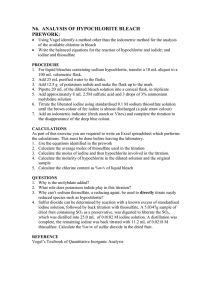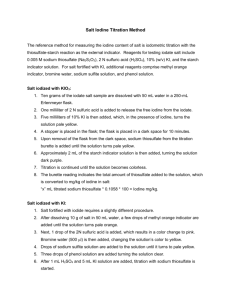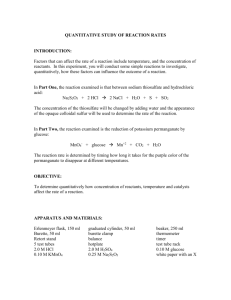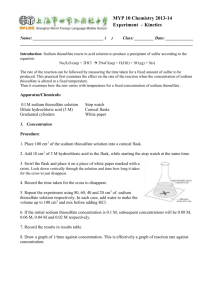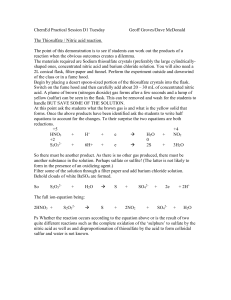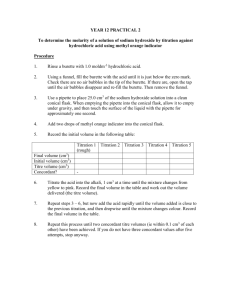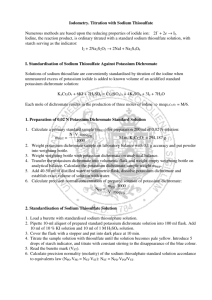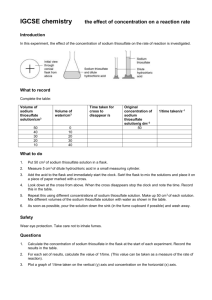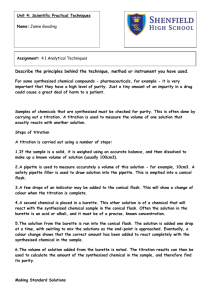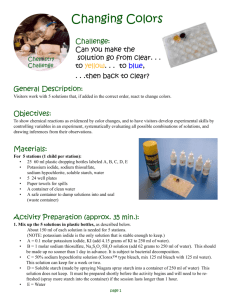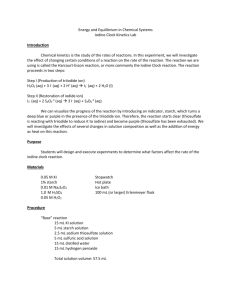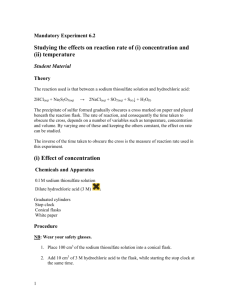An iodine / thiosulfate titration
advertisement
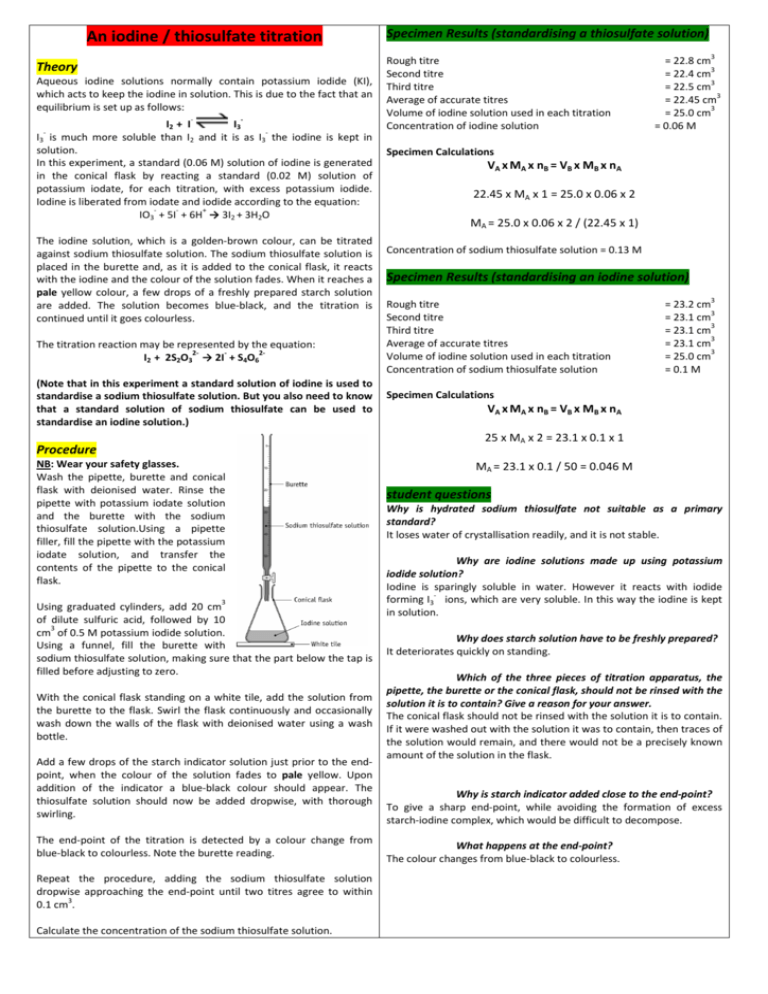
An iodine / thiosulfate titration Theory Aqueous iodine solutions normally contain potassium iodide (KI), which acts to keep the iodine in solution. This is due to the fact that an equilibrium is set up as follows: - - I3 I2 + I is much more soluble than I2 and it is as I3 the iodine is kept in solution. In this experiment, a standard (0.06 M) solution of iodine is generated in the conical flask by reacting a standard (0.02 M) solution of potassium iodate, for each titration, with excess potassium iodide. Iodine is liberated from iodate and iodide according to the equation: + IO3 + 5I + 6H → 3I2 + 3H2O I3 The iodine solution, which is a golden-brown colour, can be titrated against sodium thiosulfate solution. The sodium thiosulfate solution is placed in the burette and, as it is added to the conical flask, it reacts with the iodine and the colour of the solution fades. When it reaches a pale yellow colour, a few drops of a freshly prepared starch solution are added. The solution becomes blue-black, and the titration is continued until it goes colourless. The titration reaction may be represented by the equation: 22I2 + 2S2O3 → 2I + S4O6 (Note that in this experiment a standard solution of iodine is used to standardise a sodium thiosulfate solution. But you also need to know that a standard solution of sodium thiosulfate can be used to standardise an iodine solution.) Specimen Results (standardising a thiosulfate solution) Rough titre Second titre Third titre Average of accurate titres Volume of iodine solution used in each titration Concentration of iodine solution 3 = 22.8 cm 3 = 22.4 cm 3 = 22.5 cm 3 = 22.45 cm 3 = 25.0 cm = 0.06 M Specimen Calculations VA x MA x nB = VB x MB x nA 22.45 x MA x 1 = 25.0 x 0.06 x 2 MA = 25.0 x 0.06 x 2 / (22.45 x 1) Concentration of sodium thiosulfate solution = 0.13 M Specimen Results (standardising an iodine solution) Rough titre Second titre Third titre Average of accurate titres Volume of iodine solution used in each titration Concentration of sodium thiosulfate solution 3 = 23.2 cm 3 = 23.1 cm 3 = 23.1 cm 3 = 23.1 cm 3 = 25.0 cm = 0.1 M Specimen Calculations VA x MA x nB = VB x MB x nA 25 x MA x 2 = 23.1 x 0.1 x 1 Procedure NB: Wear your safety glasses. Wash the pipette, burette and conical flask with deionised water. Rinse the pipette with potassium iodate solution and the burette with the sodium thiosulfate solution.Using a pipette filler, fill the pipette with the potassium iodate solution, and transfer the contents of the pipette to the conical flask. 3 Using graduated cylinders, add 20 cm of dilute sulfuric acid, followed by 10 3 cm of 0.5 M potassium iodide solution. Using a funnel, fill the burette with sodium thiosulfate solution, making sure that the part below the tap is filled before adjusting to zero. With the conical flask standing on a white tile, add the solution from the burette to the flask. Swirl the flask continuously and occasionally wash down the walls of the flask with deionised water using a wash bottle. Add a few drops of the starch indicator solution just prior to the endpoint, when the colour of the solution fades to pale yellow. Upon addition of the indicator a blue-black colour should appear. The thiosulfate solution should now be added dropwise, with thorough swirling. The end-point of the titration is detected by a colour change from blue-black to colourless. Note the burette reading. Repeat the procedure, adding the sodium thiosulfate solution dropwise approaching the end-point until two titres agree to within 3 0.1 cm . Calculate the concentration of the sodium thiosulfate solution. MA = 23.1 x 0.1 / 50 = 0.046 M student questions Why is hydrated sodium thiosulfate not suitable as a primary standard? It loses water of crystallisation readily, and it is not stable. Why are iodine solutions made up using potassium iodide solution? Iodine is sparingly soluble in water. However it reacts with iodide forming I3 ions, which are very soluble. In this way the iodine is kept in solution. Why does starch solution have to be freshly prepared? It deteriorates quickly on standing. Which of the three pieces of titration apparatus, the pipette, the burette or the conical flask, should not be rinsed with the solution it is to contain? Give a reason for your answer. The conical flask should not be rinsed with the solution it is to contain. If it were washed out with the solution it was to contain, then traces of the solution would remain, and there would not be a precisely known amount of the solution in the flask. Why is starch indicator added close to the end-point? To give a sharp end-point, while avoiding the formation of excess starch-iodine complex, which would be difficult to decompose. What happens at the end-point? The colour changes from blue-black to colourless.
